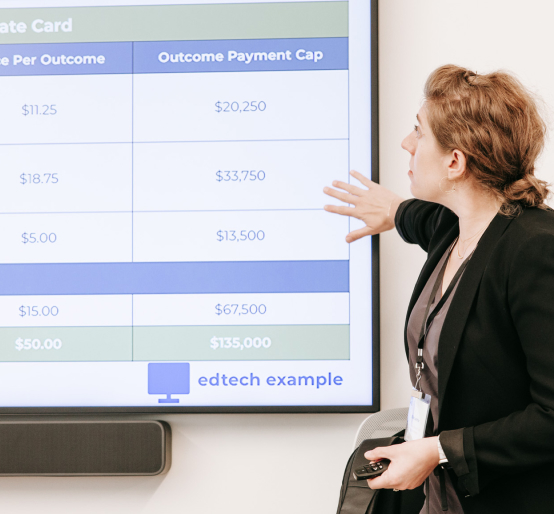Start of a Movement
The Center for Outcomes Based Contracting Standards of Excellence embody the foundational principles and concepts of outcomes based contracting (OBC), serving as the cornerstone for all related training, tools, and resources. The Standards establish clear benchmarks for outcomes based contracting across the K–12 landscape, balancing the need for robust support with accountability for maintaining high-quality contracts that drive meaningful outcomes for districts, educators, and students.
The OBC Standards of Excellence are designed to:
- Promote Consistency: Set clear, uniform expectations for OBC, ensuring the presence of critical contract components.
- Ensure Quality: Provide a rigorous framework to ensure outcomes based contracts are thoughtfully designed, high-quality, and aligned with best practices.
- Foster Efficiency: Provide a clear and efficient framework that streamlines the development of high-quality, well-defined contracts and enables scalability.
These Standards are essential for driving impactful, scalable, and sustainable improvements across the K–12 education ecosystem. They will help LEAs, ESAs, SEAs, providers, and any organizations that support them create outcomes based contracts that are clear, thorough, and designed to achieve student outcomes.
Five Domains of Outcomes Based Contracting
DOMAIN
DESCRIPTION
RATIONALE
Standards of Excellence Resources
High-Dosage Tutoring Contract (Annotated)
A full contract example with annotation aligned to the The Center for Outcomes Based Contracting’s Standards of Excellence. The purpose of this exemplar is to provide guidance and references as partnerships pursue their own OBC contracts.
High-Dosage Tutoring Contract Template
A customizable template for LEAs and SEAs to use in crafting a contract in service of an outcomes based contract (OBC) for high-dosage tutoring.
High-Dosage Tutoring Exemplar Contract
A full contract example aligned to the The Center for Outcomes Based Contracting’s Standards of Excellence. The purpose of this exemplar is to provide guidance and references as partnerships pursue their own OBC contracts.
High-Dosage Tutoring RFP Template
A customizable template for LEAs and SEAs to use in crafting a Request for Proposal (RFP) or other bid documents in service of an outcomes based contract (OBC) for high-dosage tutoring.
Standards of Excellence for Outcomes Based Contracting: High-Dosage Tutoring
The Center for Outcomes Based Contracting Standards of Excellence™ for Outcomes Based Contracting: High-Dosage Tutoring establish clear benchmarks across K-12 education. These Standards ensure quality, consistency, and efficiency, streamlining the development of successful OBCs.
High-Dosage Tutoring Exemplar Contract
A full contract example aligned to the The Center for Outcomes Based Contracting’s Standards of Excellence. The purpose of this exemplar is to provide guidance and references as partnerships pursue their own OBC contracts.
Glossary: Outcomes Based Contracting Terms and Definitions
Base Payment: Maximum contract amount available for minimum product/service delivery
Contingent Outcomes Payment: Payments that are earned only as students achieve the agreed upon outcomes
District: Any organization serving students that enters into a contract with a provider – CMOs, LEAs, regional service centers, county offices of education, state education agencies, etc.
Implementation Success Plan: Comprehensive plan designed and driven by the provider with input from the district, including but not limited to a description and timeline of professional learning, support of a success manager, a continuous improvement process, ongoing coaching, on-demand resources, and tech support. This plan articulates the responsibilities for all parties to improve implementation and drive towards agreed-upon student outcomes.
Metric: Includes assessment and measure/metric and threshold
Mutual Accountability: Agreed-upon commitments made between a district and provider, ensuring each party is responsible for the achievement of student outcomes
Mutual Accountability Mechanisms: Clear, predefined remedies for unmet partnership obligations that maintain trust and drive desired outcomes by making roles and responsibilities explicit
Outcome: Growth, gains, achievement, etc.
Outcome Payment Cap: Maximum amount paid for each payment outcome in aggregate
Payment Outcomes: Indicators of student success that are tied to payment
Price per Outcome: Amount paid per student for each payment outcome achievedProcess Outcomes: Indicators of student success and program implementation that are used to inform ongoing learning and continuous improvement but are not tied to payment
